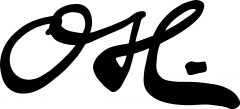
The Painter Oluf Høst
Oluf Høst was born on the 18th of March 1884 at Svaneke on the island of Bornholm. He attended various schools of art in Copenhagen between the years 1906 and 1915. These included the Academy of Fine Arts and painter Harald Giersing’s school. Through Giersing, a contemporary avant-garde artist, he extended his knowledge of European art, not least expressionism, which was regarded as a basic discipline at the school.
For Høst, it was Cézanne who had the greatest influence on his development. Cézanne was his ideal in artistic matters, although Høst emphasised the great differences between their works, which in his opinion were due to the climatic differences in their surroundings and which meant that Høst felt himself solidly anchored in a Nordic tradition.
“We have our seasons, the bright nights, the enchantment that we must struggle with, while Cézanne lived in a place where there was no weather as such, as it was always the same.”
Høst returned to Bornholm in 1929 and thereby finally had the opportunity to paint the motifs that awoke his enthusiasm and which he maintained an interest in throughout his life. Views of Gudhjem, the herring smokehouses, the St. Hans midsummer bonfires, dramatic fires and, not least, Bognemark, became recurrent motifs. The Bognemark farm, located on top of a cliff above Norresân, had already become a major motif by the end of the 20s. Høst bought the farm in 1935 and established a second studio there.
Oluf Høst married his fellow student, Hedvig Wiedemann, in 1913 with whom he had two sons, Ole and Niels. They created a home together that attracted many contemporary intellectuals, among them Otto Gelsted, who often visited them. In 1943 his eldest son, Ole, died in the little town of Barwenkowo on the Eastern Front in Russia. During the following years Høst painted a series of pictures at Bognemark facing the direction of Barwenkowo.
From Bognemark there is a view across Salene Bay to Sweden in clear weather. The farm has an east-west orientation, which led to the famous views of the sunset through the coach house. Høst painted there for years and varied the physical features of the wings and roofs of the buildings – in contrast with the light of the setting sun through the coach house – in all possible combinations. But such themes as slaughtering pigs, the cow shed and the haystacks outside the farm can also be seen in the many paintings from Bognemark.
Høst was a recognised name in Danish art as early as the 1930s and received a number of honours. Among these, he was awarded the Eckersberg Medal, the most distinguished mark of recognition a Danish artist can receive. He was a member of Den Frie Udstilling (The Free Exhibition) from 1926, but years could pass by during which he exhibited nothing because he had difficulty in letting his paintings go. He often took brushes and paint along to exhibitions to make changes to his works, something he also practised with regard to private owners where he turned up to make changes or reclaim a picture for “completion”. He often had many paintings in various stages of completion – up to 50 unfinished works – which could be under consideration and continued revision.
Throughout his life Høst wrote more than 1,500 log books which in all clarity show the biting acerbity, self-irony and subtlety that the artist possessed, both with regard to himself and his surroundings.
“I really have nothing to talk about with those people who do not like Negroes and films, and feel that cement is ugly.”
“I cannot do without the common people – nature’s loneliness and silent friendship.”

